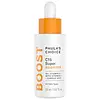What's inside
What's inside
 Key Ingredients
Key Ingredients

 Benefits
Benefits

 Concerns
Concerns

No concerns
 Ingredients Side-by-side
Ingredients Side-by-side

Water
Skin ConditioningPropylene Glycol
HumectantSnail Secretion Filtrate
Skin ConditioningButylene Glycol
Humectant3-O-Ethyl Ascorbic Acid
Skin ConditioningDimethyl Isosorbide
SolventAscorbic Acid
AntioxidantPolysorbate 20
EmulsifyingGlycosaminoglycans
EmollientSodium Hyaluronate
HumectantTrisodium Ethylenediamine Disuccinate
Sodium Hydroxide
BufferingTocopheryl Acetate
AntioxidantPhenoxyethanol
PreservativeBenzoic Acid
MaskingDehydroacetic Acid
PreservativeParfum
MaskingWater, Propylene Glycol, Snail Secretion Filtrate, Butylene Glycol, 3-O-Ethyl Ascorbic Acid, Dimethyl Isosorbide, Ascorbic Acid, Polysorbate 20, Glycosaminoglycans, Sodium Hyaluronate, Trisodium Ethylenediamine Disuccinate, Sodium Hydroxide, Tocopheryl Acetate, Phenoxyethanol, Benzoic Acid, Dehydroacetic Acid, Parfum
Water
Skin ConditioningAscorbic Acid
AntioxidantGlycerin
HumectantEthoxydiglycol
HumectantPPG-26-Buteth-26
Skin ConditioningMannitol
HumectantTridecapeptide-1
Skin ConditioningPalmitoyl Tripeptide-5
Skin ConditioningErgothioneine
AntioxidantSodium Hyaluronate
HumectantPentylene Glycol
Skin ConditioningPEG-40 Hydrogenated Castor Oil
EmulsifyingBisabolol
MaskingSodium Gluconate
Skin ConditioningDecylene Glycol
Skin ConditioningFerulic Acid
AntimicrobialOryza Sativa Bran Extract
Skin ConditioningTocopherol
AntioxidantPolyacrylate Crosspolymer-6
Emulsion Stabilising1,2-Hexanediol
Skin ConditioningPanthenol
Skin ConditioningSodium Phytate
Sodium Hydroxide
BufferingCitric Acid
BufferingPhenoxyethanol
PreservativeWater, Ascorbic Acid, Glycerin, Ethoxydiglycol, PPG-26-Buteth-26, Mannitol, Tridecapeptide-1, Palmitoyl Tripeptide-5, Ergothioneine, Sodium Hyaluronate, Pentylene Glycol, PEG-40 Hydrogenated Castor Oil, Bisabolol, Sodium Gluconate, Decylene Glycol, Ferulic Acid, Oryza Sativa Bran Extract, Tocopherol, Polyacrylate Crosspolymer-6, 1,2-Hexanediol, Panthenol, Sodium Phytate, Sodium Hydroxide, Citric Acid, Phenoxyethanol
 Reviews
Reviews

Ingredients Explained
These ingredients are found in both products.
Ingredients higher up in an ingredient list are typically present in a larger amount.
Ascorbic Acid is is pure Vitamin C. This form makes up the largest amount of vitamin C found naturally in our skin.
Not only is vitamin C great for your overall health and immune system, it also has plenty of benefits on your skin.
Vitamin C is best used for brightening skin. It improves dark spots, acne scars, and hyperpigmentation. This is because it blocks the process of skin darkening when exposed to UV.
Remember: Vitamin C should not replace sunscreen!
Your skin uses vitamin C to build collagen. Collagen is one key component in having a strong skin barrier and plump skin. Vitamin C also plays a role in regulating collagen, thus making it effective in improving wrinkles and fine lines.
Ascorbic acid shows potent antioxidant activity. As an antioxidant, it helps fight free-radicals. Free-radicals are molecules that may damage your skin cells. These antioxidants also protect skin against UV damage.
The best formulations include Vitamin E and/or ferulic acid. These two ingredients help stabilize and provide a boost in the benefits of ascorbic acid. This is because ascorbic acid becomes unstable when exposed to UV and air. In fact, you can tell your ascorbic acid has oxidized when it turns an orange-yellow color.
Ascorbic acid is generally compatible with other ingredients. However, using ascorbic acid with other active ingredients might cause irritation. Two ingredients: copper ions and benzoyl peroxide, will inactivate ascorbic acid completely.
Read more about other types of Vitamin C:
Foods rich with vitamin C include oranges, strawberries, broccoli, bell peppers, and more. When consuming Vitamin C, your skin receives a portion of the nutrients.
Learn more about Ascorbic AcidPhenoxyethanol is a preservative that has germicide, antimicrobial, and aromatic properties. Studies show that phenoxyethanol can prevent microbial growth. By itself, it has a scent that is similar to that of a rose.
It's often used in formulations along with Caprylyl Glycol to preserve the shelf life of products.
Sodium Hyaluronate is hyaluronic acid's salt form. It is commonly derived from the sodium salt of hyaluronic acid.
Like hyaluronic acid, it is great at holding water and acts as a humectant. This makes it a great skin hydrating ingredient.
Sodium Hyaluronate is naturally occurring in our bodies and is mostly found in eye fluid and joints.
These are some other common types of Hyaluronic Acid:
Learn more about Sodium HyaluronateSodium Hydroxide is also known as lye or caustic soda. It is used to adjust the pH of products; many ingredients require a specific pH to be effective.
In small amounts, sodium hydroxide is considered safe to use. However, large amounts may cause chemical burns due to its high alkaline.
Your skin has a natural pH and acid mantle. This acid mantle helps prevent harmful bacteria from breaking through. The acid mantle also helps keep your skin hydrated.
"Alkaline" refers to a high pH level. A low pH level would be considered acidic.
Learn more about Sodium HydroxideWater. It's the most common cosmetic ingredient of all. You'll usually see it at the top of ingredient lists, meaning that it makes up the largest part of the product.
So why is it so popular? Water most often acts as a solvent - this means that it helps dissolve other ingredients into the formulation.
You'll also recognize water as that liquid we all need to stay alive. If you see this, drink a glass of water. Stay hydrated!
Learn more about Water